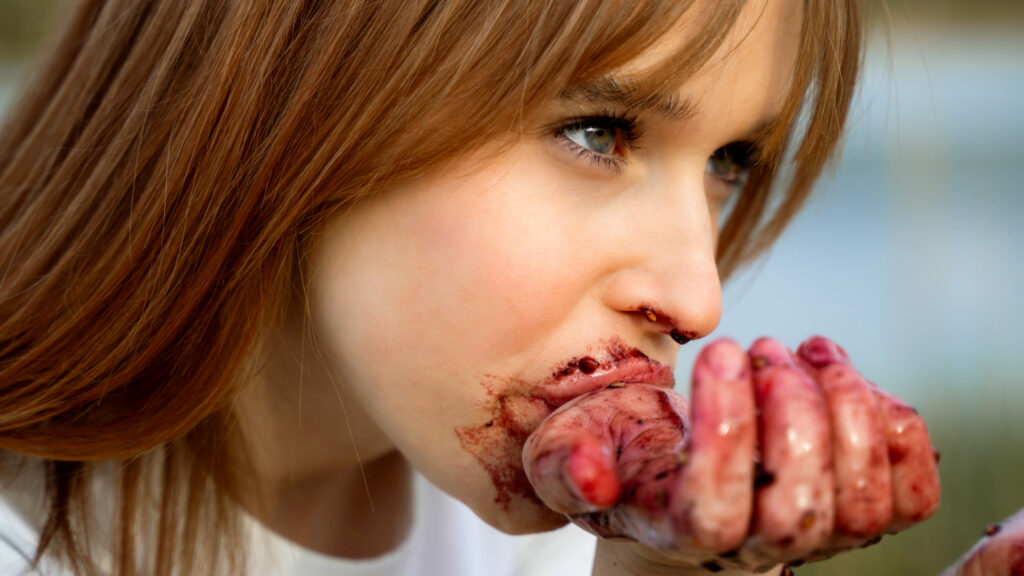On the mucky carpet of an arcade that smells vaguely of chilli heatwave Doritos appears the enigmatic spectacle of a claw machine where upon closer inspection a patchwork of soft plushies appear haphazardly positioned inside its polycarbonate walls, the factory stitched toys entombed there like the bugs in tree resin fossilised in time by the natural plastic we call amber.
Amidst the miscibility of artificial illumination and a super sus ahegao sound effect sits a particularly cursed looking Pikachu, precarious and lopsided behind that transparent polycarbonate sheeting designed to look like glass but never quite possessing the same lustrous appeal of what Jean Baudrillard thought of as the material of the future.
Beneath this Pikachu and the polycarbonate sheeting however is a sticker presented in the vibrant yellow reserved for electric fence warnings and beware the dog signposts, a sticker presented beside the coin operated joystick revealing that this claw machine is – in fact – alarmed.
I don’t dare kick it.
Pikachu’s tail is similarly yellow, of course, which is to say, slightly cursed by way of its association with the Mandela effect in action; a conspiracy theory which recounts either a shift into parallel dimensions or perhaps the cunning attempt by world elites to see just how much of history they can change until we notice, starting with, it seems, the removal of Mr. Monopoly’s monocle from the game box alongside the cultural amnesia of the black tip once present at the end of Pikachu’s tail which is now – in the case of this plushie toy – all-yellow.
What’s more important than entering either parallel dimension or political conspiracy is the irrefutable desire to win this plushie toy in a game of chance whereby the promise of temporary gratification is achieved through the ritualistic dance of insertion and retrieval.
What’s interesting about claw machines is how the promise of acquisition eclipses the pervasive sense of emptiness we all feel in a world where gambling, in the Baudrillardian sense of the word, reveals a great deal about a culture predicated upon the phenomenological qualities of risk.
Claw machines are one of those strange things I enjoy looking at – and like so much of what takes place under systems of hyperculture, the claw machine is one of those peculiarities that make sense only in the environmental context in which they find themselves. In this case, the environment is that of a transitional space that acts as a threshold of sorts between a bowling alley and a bar, more specifically, the claw machine placed beside a pool table; a skill game that stands practically antithetical to the luck required in dumping a mechanical claw into a plushie pit and hoping for the best.
The pool table beside the claw machine has been stretched with a pleasant, blue fabric. It is the same colour of an aquarium under the right lighting. In my mind I’m playing the pool cue behind my back now, hoping to impress an audience of pretty girls, telling my opponent that “coach told me I could have gone pro” when really I’m observing two girls playing away, breaking the perfect, polished triangle before them, the warm professionalism of the blue fabric far nicer perhaps than the classic green fabric found in franchise pubs and family restaurants, where the tournament blue in contrast, practically turquoise in the neon light, remains second in its appeal to the occasionally sighted burgundy cloth which is superior, in my opinion, for no other reason than being as rare as a mint condition Charizard.
Play enough pool on these decaying fabrics, worn with age and repetitive use, and observe how each table – like each decaying culture – develops with its own unspoken hazards of play, where a deep knowledge of the dips and gullies of the cloth, whatever its colour, becomes integral to exhibiting any real skill at the game.
What’s funny about the contemporary phenomenon of bars in arcades – or perhaps it’s arcades in bars – is the varying degrees of anemoia produced in the semiotic outlay where those environments which were once attuned to an aesthetics of adult sophistication have been shelved in favour of the ecstasy of the arcade, of eternal youth, of staying young forever in the gamification of the social environment today relegated to the physicality of air hockey.
It is worth mentioning that arcade bars aren’t cool but rather the very millennial impression of what cool should have been, and when one visits an arcade in this way I cannot help but detect a worrying disconnect between the arcade as it is and the arcade as we imagine it to be. To find a successful instance of where this aesthetic cohabitation of arcade and bar still remains you’re going to have to visit The Stardrop Saloon to find a pool table of neither blue nor burgundy but rather the aforementioned casual-dinning green; an aesthetic dimension disappeared from reality and reconstituted in an environment which is today best felt virtually.
There was once a time when you could win a pre-mandela effect Pikachu, order a lemonade with strawberry syrup and use the twenty-pence skittles dispensary without the use of hand sanitiser. It seems the world I was raised in doesn’t exist anymore.
Passing from one area to another, from claw machine to bar, and the only real change that occurs is felt underfoot, felt in the way shoes pass from those chilli heatwave carpets to the stickier floors of all those spilt beverages on the other side of the signs that stipulate ‘adults only’. One cannot help but wonder if it’s the children who put up these signs up in order to to remind the infantilised who they are and where they really belong.
Next story


